Text
what should i review next? anybody have requests :-D
1 note
·
View note
Text
CRUISIN’ 4 A BRUISIN’ (Gokusen)
by Kozueko Morimoto | 156 chapters | 1999-2007
9/10
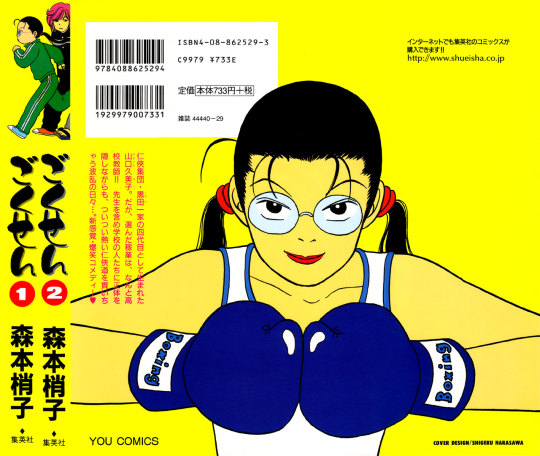
Gokusen is your typical relatable Josei manga: The protagonist, a mousy-looking girl, embarks on a quest to find love while trying to balance work life and home life. Except in this case work life is being a grade school teacher at an all-boys school, and home life is being a Yakuza heiress. This manga balances drama, comedy, and action, and oh my god, it’s so good. I started this review several months ago and I’m just finishing it now, but is it crazy for me to say I want to go back and re-read it already?
There is an unstoppable joy in Morimoto’s characterization of the protagonist, Yankumi. It’s honestly pretty cathartic to watch Yankumi bring her Yakuza know-how to public school, because lord knows the power structure of the educational institution could use a good ass-kicking. Yankumi’s teaching style can only be described as tough love, and none of the romance drama interferes with her ability to persevere and show a great deal of love to her students, family, and friends. It is so delightfully refreshing to read a manga where the protagonist is a compassionate, loyal, unfuckwithable, cop-hating teacher practicing non-hierarchical pedagogy! Emphasis on the cop-hating. I take issue with people who complain about “weak and annoying” female characters (that just sounds like a personal diss to me, ouch), but if you really just want to watch a girl utterly and completely fuck people up, Gokusen is the way to go.
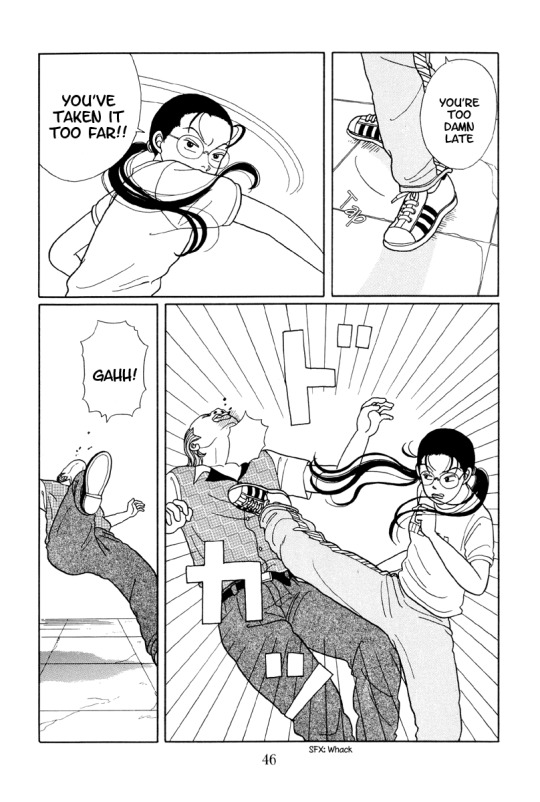
What makes Gokusen so strong is how well it sticks to our Yakuza princess’s moral integrity: Nobody is irredeemable, not even mob bosses and snot-nosed teenage boys. Despite violence being her preferred solution for any problem, Yankumi isn’t hungry for power, nor does she slap people up because she wants to eradicate them. She acknowledges that her power, be it as a Yakuza heiress or a schoolteacher, can be used to improve the world, which very much appeals to me as a believer in transformative justice. I always recall my roommate telling me, after I relayed my firm stance on nonviolence, that some people really just need a punch to the face to really make them stop acting a fool. Gokusen effectively pulls off this ethos by using its buoyant and crisp tone. This manga is about beating people to a pulp and then helping them get back up again.
The second half of the series had moments that made me explode with laughter which I think is pretty hard for a comic to do! If you like Daria or even Beavis and Butthead I think this definitely scratches that itch. Just a note that there are some jokes made about pedophilia in the story, so that’s something to beware of if you’re sensitive to it. Beyond just jokes though, the main love interest is one of the high schoolers, but I actually found that plotline pretty sweet and interesting - Yankumi shows little to no romantic interest in him and most of their relationship is about him trying to prove himself to her as an adult, which hits home for me. Does that make me messed up? Did other people fantasize about a teacher or two when they were in grade school? I found that Morimoto handled that emotional landscape with serious honesty when it could have quickly become rocky territory.

Why do I see so many people complaining about Gokusen’s artwork online? Even in the first volume, when the proportions are a little funny and the lines aren’t as confident, I found the expressions and character designs irresistibly endearing. It’s got a simpler slapstick artstyle common in these older mangas that reminds me of a mix of Stop!! Hibari-Kun! and Urusei Yatsura but with a Josei twist. Ultimately the art style works in service to the writing style, which has serious moments treating characters’ intentions with levity; but also is riddled with hilarious scenarios. The sparse backgrounds allow for the focus to facial expressions and character gestures.
Just go read this manga, it’s so kickass and sweet and there is so much cop hatred. It’s for the kids who have bottomless amounts of both love and violence burning a hole in our hearts.
73 notes
·
View notes
Text
IN THE GAMER CLOSET (Wotakoi: Love is Hard for Otaku)
by Fujita | 11 volumes | 2014-2021
6.5/10

I’m surprised I haven’t read this one before because it’s really popular and allegedly marketed as josei (according to Wikipedia). Perhaps it’s because Wotakoi started on Pixiv as a webcomic. The early chapters fall victim to the rigid, screen-catered panelling and cropping common in webtoons, but it falls away as the work goes into print. It’s cool to see how much the art changes overtime, I have a soft spot in my heart for projects that have a scrappy start.
I find this manga particularly interesting though, because it seems to fulfill, IMO, a specific and common hetero male fantasy right in the premise: Childhood friends reconnect years later in the workforce and bond over the fact that they are still otaku (anime/gaming nerds). The lead male character, Hirotaka, has difficulty expressing his feelings and spends literally all of his free time gaming but scores his childhood crush who loves and accepts him for who he is because she’s equally a “freak” (albeit a more sociable one). I don’t think there’s anything wrong with this fantasy, I don’t use that word with derision; a good romance plays out, and plays with, our collective desires and it’s nice to see a nontoxic fantasy for boys to enjoy. That’s why it doesn’t really feel like josei to me, though - it’s not twisted, it’s not dark, it’s pretty straightforward. There’s not really any of the difficult contradictions I associate with manga geared towards the tortured musings of the adult woman’s mind (lol). I guess I might be biased because my favourite love stories happen to also involve mature topics like realistic representations of labour, gay angst, death and suicide, sex, sex work, gang violence, eating disorders...

Wotakoi almost feels like a seinen premise dressed in shoujo clothes for how light and fluffy it is despite being geared towards an older audience. If it seems I’m hyperfixated on these demographic categories, forgive me, but I think this is a useful angle for analyzing how the story operates. Wotakoi feels a bit like Horimiya (classic tropes of relationship dynamics from both lighthearted and serious angles) meets Sweat and Soap (weirdos in an office setting). I mean hell, one of the romantic side stories was basically just Kimi Ni Todoke action, simplified. I knew what was happening instantly there with Ko and Naoya but I still enjoyed its unfolding. Perhaps it’s more special if you read Ko as genderqueer...?
I understand the argument for Wotakoi being a josei manga, though - I really enjoyed the characterization of the female main, Narumi, with her nerdy interests and how she feels the need to keep it a secret. I was like, “this is exactly how I feel thinking about how I can’t let my students know that I love watching competitive Smash!” (lol.) I liked seeing her friendships with all the different characters, too. The MMORPG sessions with the group, the chance encounters at the manga store, the degenerate collective fantasies between Narumi and Hanako; these situations are all great. It’s this larger social network that really bring the story to life, in my opinion - just the individual romances alone feel a bit too one-note in their progression for me. Which is weird, because that’s usually the juicy part that I’m wanting the most.

That brings me to the biggest issue I have with the manga. The story is super relaxing to read because it incorporates familiar romantic tropes in a lighthearted tone, and since it’s for an older audience, the characterization feels more realistic in maturity and not over-the-top (unlike Horimiya featuring highschoolers with extreme characterization, who become caricature-like after the first part of the story). On one hand, I appreciate that they’re not acting like caricatures; on the other hand, they still don’t quite have as much dimensionality as I would like to because it feels like everything is going so even and steady all the time. I never really felt like there were stakes or that anything was really in danger of being lost or damaged. I feel like I would have really enjoyed if that subtle characterization was paired with more complex narratives and emotional stakes. There’s something that feels a bit surface or underdeveloped to me in this series, like the author’s refusal to draw the faces of side characters, which becomes a running gag and gets better by the end. Maybe this “stopping short” is a remnant of its doujin-esque roots. Similarly, while the panelling and pacing improves as the series continues, I actually prefer the character designs in the first volume just because they look less cookie-cutter conventionally attractive. There’s something a little more toothy about the rockier art at the beginning.
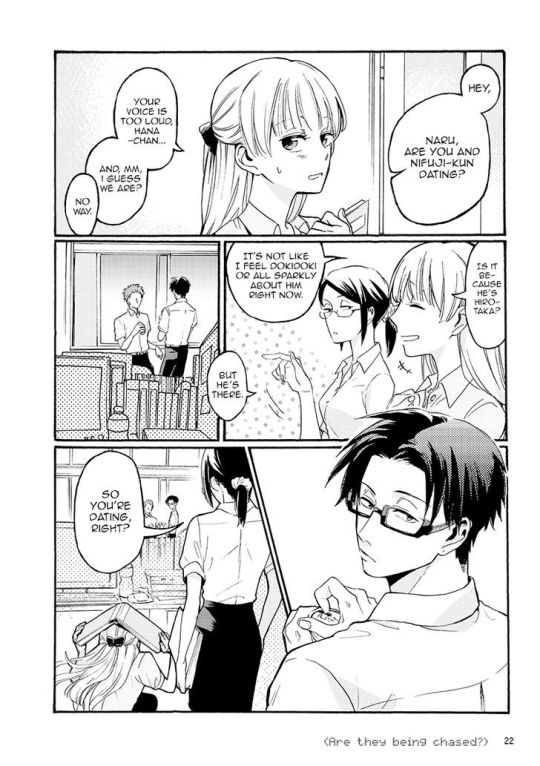
On the other hand, maybe who cares about “tooth” and it’s just a comforting story for all demographics to enjoy. I thought the ending was lackluster at first but then I realized that it ties things up well in terms of emotional arcs and not everything has to culminate in some crazy dramatic shoujo ending. Hirotaka and Narumi are the chill and low-drama otaku couple, after all. Considering how much Wotakoi plays cliche romance tropes like angsty confessions, angsty group trips, etc. in a pretty conventional way (nothing about the panelling or art felt too exciting or avant-garde to me), I was surprised by how much I liked it. I found it a bit too toothless to really be great but I still had a good time reading it. The art and characters are pleasurable and relaxing to follow and it was cool to see a slice of life so attuned to contemporary internet culture. More gamer mangas please!
P.S. sorry it’s been a while, I realized that I can’t pump out reviews at the standard I want so I’ve given up on polishing them in favour of recording my feelings. So reviews might be a bit inconsistent in style from now on!
#wotakoi#wotaku ni koi wa muzukashii#wotakoi love is hard for otaku#fujita#josei#manga#manga review#josei review#6.5
2 notes
·
View notes
Text
BAD BOYS WITH DEATH DRIVES (Mars)
by Fuyumi Soryo | 15 chapters | 1996-2000
8.5/10
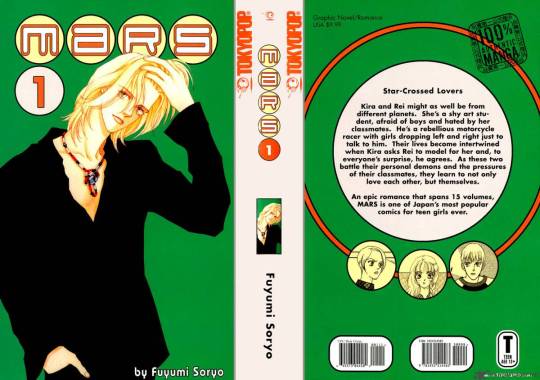
I’m sick of all these shoujo schoolgirl romances that aren’t willing to make their “bad boy” archetypes actually bad: dangerously violent, traumatized, panic attack-prone motorcycle racers. I think that’s the best way to describe the male love interest of Mars, Rei Kashino, a daredevil who is psychologically haunted by his twin brother’s suicide three years before. Then there’s Kira Asou, a quiet and closed-off artist loner carrying her own trauma from sexual assault. When the two begin an unlikely romance they slowly learn and grow together. Sometimes they mess up and hurt each other along the way, but the key trait of their relationship is how they manage to change each other, and change together.
It’s surprising how many shoujo series take the idea of change and growth at a superficial level, or just allow relationship dynamics to fall into lazy tropes and patterns for comfort/amusement. Which is weird because the shoujo genre mostly consists of high school romances, and isn’t adolescence defined by transformation? Mars, on the other hand, understands this and takes it to heart - Fuyumi Soryo never shies away away from the discomfort that comes with growing maturity. She’s written characters here that are desperate and sensitive and cunning; who understand that if they don’t adapt, they won’t survive.

Soryo’s panels descend hazily into cascading vignettes. The emphasis on verticality gives the effect of a heart dropping in its chest, adding to the serious tone maintained throughout the entirety of the manga. The gravity of drama is also emphasized by the sparse internal narration from Kira. Sometimes we get a few short lines of thoughts she’s having, but most of the time her emotions are conveyed through flashbacks or just frames that show nothing but her eyes (the artist looking on attentively). The emotional beats and body language are reminiscent of Joanna Newsom’s “It Does Not Suffice”: I have gotten into / Some terrible trouble / Beneath your blank and rinsing gaze...
As for the dialogue, the characters are refreshingly articulate about their feelings and speak with a lucidity that prevents Mars from ever feeling juvenile or trite or too “loud”. Just like Kira’s character, there’s a quiet restraint to the storytelling that develops from the tight linework and intense storytelling.
As a result, I was pleasantly shocked at how believably this manga treats trauma. I never felt like I was being hit over the head with obvious emotional notes. It really delves into the complications of grief and guilt as we’re let in to each character’s particular struggle. In one sequence shown below, snatches of violent memory are interweaved with expressions of a physical intimacy: In an expert handling of the panel form, a moment that should be tender and loving fractures in the prism of Kira’s mind.

Mars isn’t afraid to stray from moral questions, either. Characters are often preoccupied with “good” and “bad”, punishing themselves or confessing to violence or mean-spirited responses to the trials and tribulations of life. These issues seem to haunt Rei in particular as he attempts to balance his recklessness and dark past with his love for Kira. Rei’s struggle with his own moral flaws draw in the reader just as it draws in Kira’s gaze. Subconscious thoughts threaten the hope for a better life as dangerously as Rei’s motorbike tearing through the racetrack.
Rei (to Kira): When you look at me like that, I really can’t stand it. I keep thinking that one day you’re going to look at me the same way Sei and my father did.
My father’s eyes...so full of hatred, but scared, too. He doesn’t think of me as another human being...
those eyes deny everything about me.
When someone looks at me like that,
I don’t know what I am anymore.
I don’t know who I am anymore.
(Mars, Volume 7)
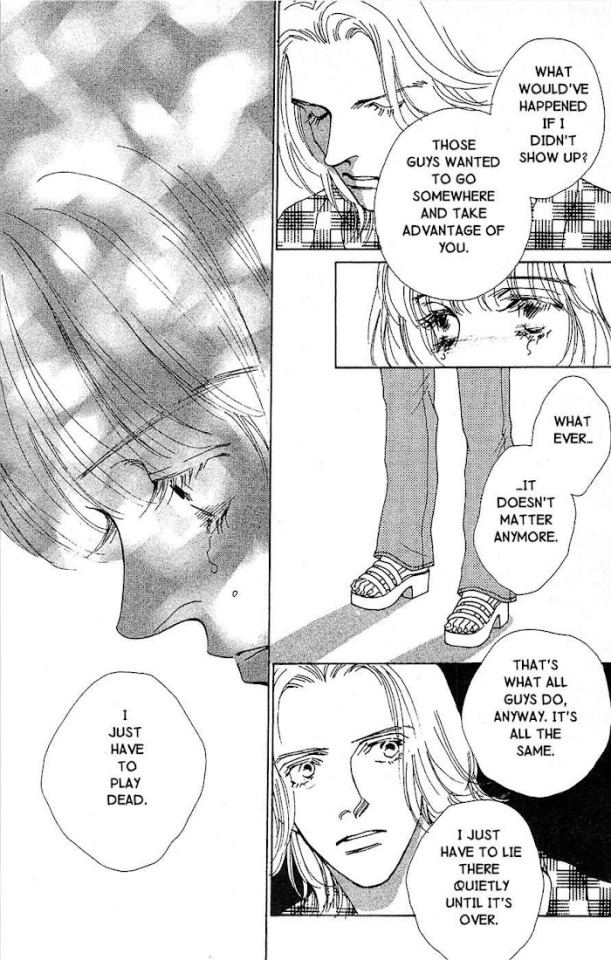
Despite how serious the subject matter gets, Mars is ultimately about two kids who are hurt and trying their best to do right by each other. Soryo balances realism and melodrama as she creates an all-consuming vortex that is the central romance of Mars. It’s the kind of romance only adolescent minds can get caught in: So entwined that they need each other to stay upright and so soft they they change in response to the other’s every move. You really feel the depth and power of that vortex...maybe the kids are going to be alright.
Rei: A long time ago, when [Shiori] or Sei would cry, I really wanted to do something. But...
When Kira cries... I just... don’t know what to do.
It makes me want to cry, too.
(Mars, Volume 5)
P.S. Why do I like older mangas so much? I’m noticing my bias. Something about the specificity of the anatomy, the stylishness, the line quality really creates a warm feeling for me. Also, Fuyumi Soryo is making eyebrows that are bushier on the sides hot again, and for that I must thank her a thousand times.
48 notes
·
View notes
Text
FINALLY UNDERSTANDING CLASSICAL MUSIC (Nodame Cantabile)
by Tomoko Nidomiya | 150 chapters | 2001-2010
7.5/10

There’s so much about Nodame Cantabile that makes it fresh and unique. The storytelling, like the artwork, is quick, light, and sparse. It follows classical musician/conductor prodigy Shinichi Chiaki and goofball pianist Noda Megumi (aka Nodame), and their respective journeys in the professional world of classical music. Chiaki is self-serious and closed; conversely, Nodame is eccentric, unconventional, and happy-go-lucky. Their relationship develops as they make friends and grapple with their own dreams and expectations in the world of music.
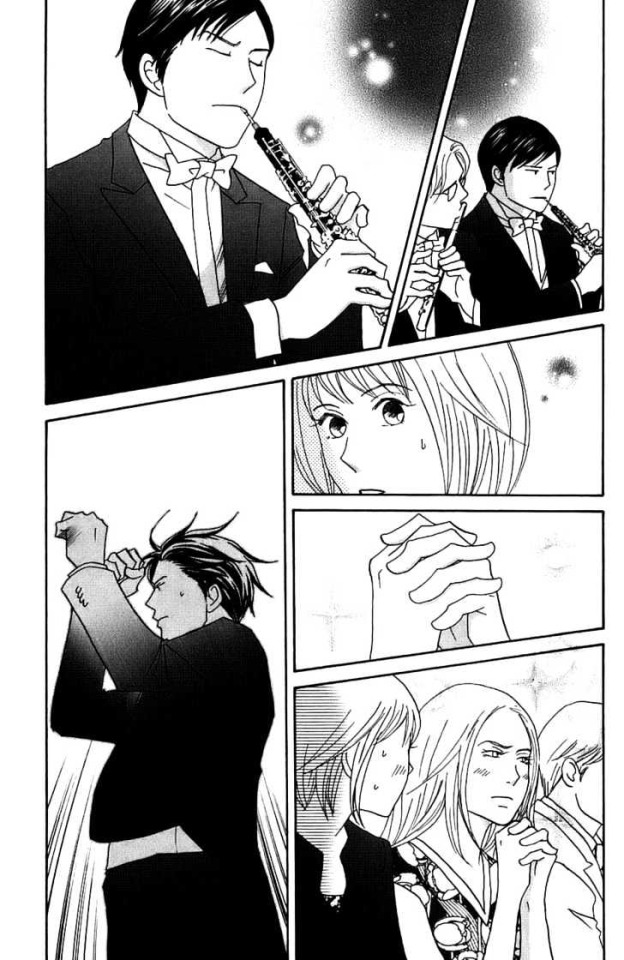
Tomoko Nidoyima masterfully captures the feeling of music with no audio at all, breathing life into the story. When the orchestra plays in perfect harmony, flowers bloom as the panels sprawl into expansive fields; when Nodame bangs out her freewheeling piano improvisations, puppets and animals dance like twinkling stars. This allegorical imagery, paired with the simplified yet surgically illustrated anatomy of the performers themselves, transport the reader directly into a room filled with light and music. The enthusiasm and passion of the characters is infectious too.
Nidoyima illustrates her world with great clarity and economy of mark: There are never more lines than there need to be. Facial expressions are distant and subtle. Rather than overindulging in the bells and whistles the characters’ style and appearance, it’s the pacing of dialogue and rhythms of panelling that hit us hard.
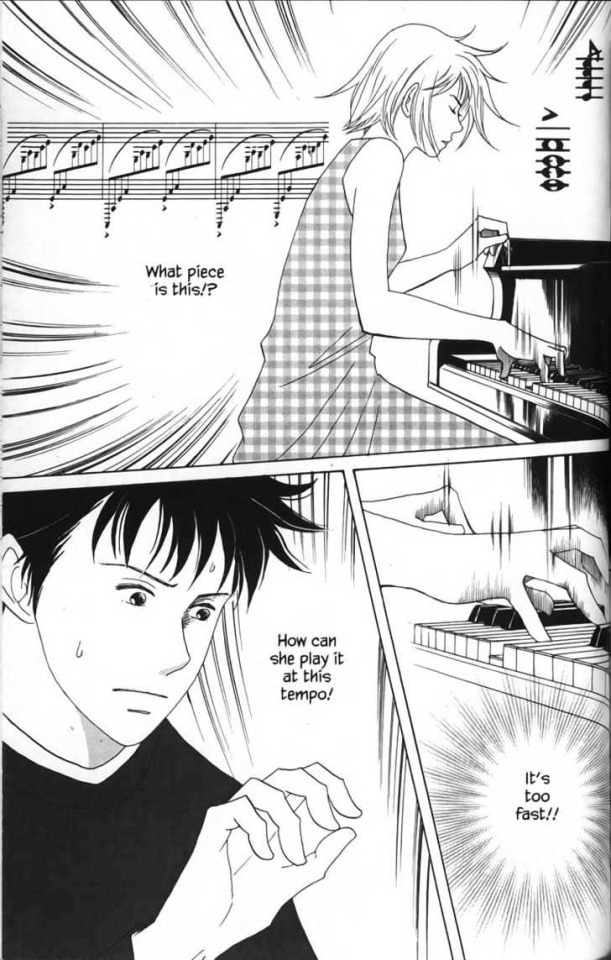
Nodame Cantabile really strays far from cheesy romance tropes. In fact, it feels allergic to intimacy at times - some of the romantic tangents don’t seem to pay off or resolve at all. But that’s what makes this manga feel sincerely mature too, despite the characters’ antics. Everyone is dedicating their life to their labour and passion intermixed, and any romantic moments are subtle and never overdone. Even Nodame, who is the clown and comedic relief of the series, has complicated instincts and motivations that I sympathized with immediately.
However, I did sometimes crave more movement and development in Nodame and Chiaki’s relationship, particularly because they act as the central unit that other characters orbit around. Some of the plot point and character motivations appear out of the blue and aren’t exactly successfully played off as a “quirk” (since when did Chiaki dream of conducting an opera? Would Nodame really run away without telling anyone for so long?) Rather than build up to a cathartic ending, tension and pacing washes gently over the reader in constant waves. Most of the time it feels like the main characters develop their careers in parallel with each other, watching and cheering from the sidelines, which has its own sweet appeal.
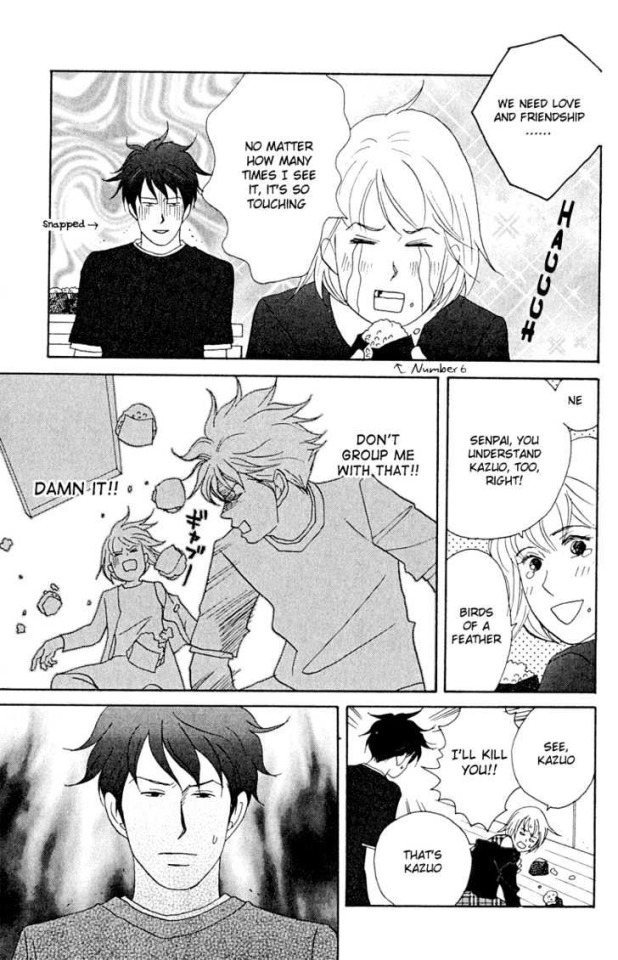
As much as Nodame Cantabile made me laugh out loud on numerous occasions, there were also moments where I felt the humour sometimes fell flat. I don’t love jokes that rely on being fat as the punchline. Nor was blackface necessary to illustrate during a certain opera production. Nor can casual sexual harassment be played off as a gag. We can chalk it up partially to cultural differences if we want, but these brief tone-deaf moments still really soured the manga’s attempt to be a light and crisp romp.
What I appreciate the most about this manga is how thoroughly it thrust me into the highs and lows of these characters trying to make it in the cutthroat classical music scene. They never let their egos get in the way of being hardworking, passionate, and inspiring. Nodame Cantabile doesn’t rely on cheap romance tropes to build dramatic tension... the power of the music is enough.
8 notes
·
View notes
Text
PET PLAY IS IN THE AIR (Tramps Like Us / Kimi Wa Petto)
by Yayoi Ogawa | 82 chapters | 2000-2005
8/10
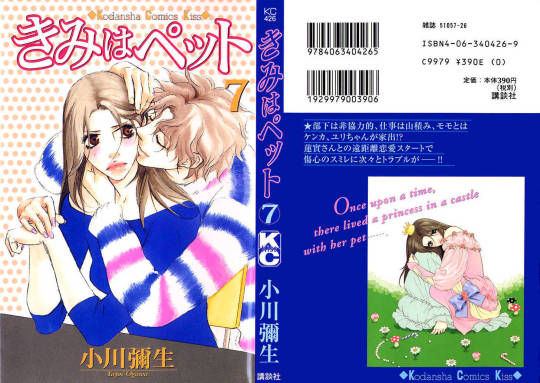
What scratches a deeper fantasy than the premise of this manga? Sumire Iwaya is a cold, capable careerwoman who happens to find a young man sleeping in a box in the alley next to her house. She brings him in, names him Momo, and provides him food, shelter, and warmth, under the condition that he serves as her pet. Every night after work, Sumire expects to return to a hungry and faithful Momo.
I’ve never read a manga that indulges so playfully with power dynamics and that’s what I loved most about it. Tramps Like Us tends carefully to its unusual and debaucherous premise with rich, dramatic, close-quarters storytelling. It’s through this care that we get to see the characters’ pretend-relationship develop and unfurl: Momo plays along, at first, with Sumire’s fantasy; that in exchange for taking care of somebody, she could receive unconditional love in return. Before long, though, Sumire realizes: What if I actually need Momo more than he needs me? Indeed, even though the presence of sex is nonexistent in Momo and Sumire’s relationship, Tramps Like Us demonstrates well that the “submissive” role is the one that holds the most power. The shell of the careerwoman begins to crack.

After all, Momo can’t hide the complications of his life as a dance prodigy forever. Nor can Sumire hide her feelings toward her suitor and teenage crush, Shigehito Hasumi, a kind and diligent man who belongs solidly in the straight world. When these external forces beyond the domestic walls begin to spill into Sumire’s sanctuary, it’s clear that their fantasy relation is fragile and unsustainable. This is the main tension of the story, but also what I found the most frustrating. It drags on this same tension of “will they stop playing this secret game and accept their true feelings for each other?” for what seems like the entirety of 14 volumes. As a result, the evolution of their relationship is slow and at times completely unchanging. But perhaps it fits what the manga is all about - the frustrating stasis of a relationship built purely on the foundation of fantasy. The characters in all their flaws seem to always be stuck between the same rocks and hard places. I guess that’s life, though.
Despite that, Yayoi Ogawa tells the story with a sweet lushness that balances out the difficulties well. Even the side characters are fleshed out with their own considered motives. What retains my attention most is the beating heart of the manga, the artwork. The linework is well-varied and figure-focused: Ogawa draws effortlessly tousled hair and soft lips on touchable faces. And then there are the dancing sequences, which Ogawa does not skip anatomy references on. They’re downright gorgeous and powerful, highlighting the contrast between the goofy, pet version of Momo and the Momo who is seriously fixated on expressing his craft.
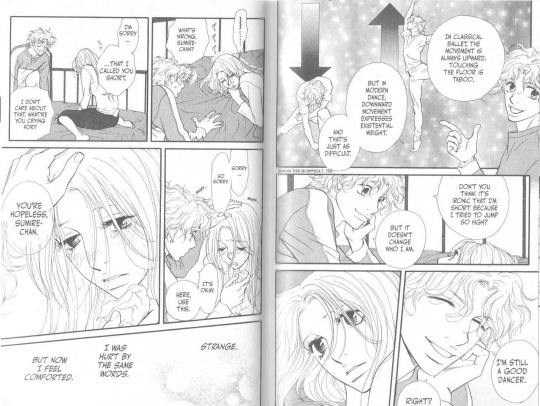
It only took a few chapters of reading for me to sympathize with these characters who desperately grapple for a sense of control over their lives and feelings. A story that simultaneously complicates and reveres fantasy. What more can you ask for from Josei manga?
P.S. obligatory link to this video for the ferally minded.
16 notes
·
View notes